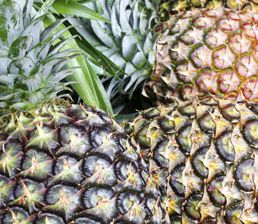 Growcom represents the biosecurity interests of pineapple producers and the industry. They are members of Plant Health Australia and signatories to the Emergency Plant Pest Response Deed. Their responsibilities include:
Growcom represents the biosecurity interests of pineapple producers and the industry. They are members of Plant Health Australia and signatories to the Emergency Plant Pest Response Deed. Their responsibilities include:
- biosecurity planning and implementation at the national and farm levels
- liaising with federal and state governments on trade issues
- funding and supporting biosecurity initiatives
- participating in national committees and response efforts in an emergency.
Industry overview
There are approximately 75 commercial pineapple enterprises, with all but one based in Queensland. Key growing districts are in Wamuran, Elimba, Glasshouse Mountains, Beerwah, Yandina, Maryborough, Hervey Bay, Childers, Bundaberg, Cawarral, Yeppoon, Rollingstone, Mutarnee, Bilyana and Mareeba, with one commercial farm located just outside Darwin in the Northern Territory.
Australia produces less than one per cent of the world’s fresh pineapple but supplies almost the entire domestic market. Four primary packing houses pack and market more than 70 per cent of fresh pineapples.
Approximately 69 per cent of the pineapple varieties grown are smooth Cayenne and 31 per cent of plantings are hybrid varieties that appeal more to the fresh market and this proportion is expected to increase.
Biosecurity plans, manuals and resources
Expand
 Biosecurity Plan for the Pineapple Industry
Biosecurity Plan for the Pineapple Industry
Biosecurity planning provides a mechanism for the pineapple industry, government and other relevant stakeholders to assess current biosecurity practices and future biosecurity needs. Biosecurity planning identifies procedures that can be put in place to reduce the chance of pests reaching our borders or minimise the impact if a pest incursion occurs.
The Biosecurity Plan for the Pineapple Industry outlines key threats to the industry, risk mitigation plans, identification and categorisation of exotic pests and contingency plans. For a copy, please contact PHA on 02 6215 7700 or email biosecurity@phau.com.au.
 The Exotic Pest Identification and Surveillance Guide for Tropical Horticulture was developed with funding from the Australia Government Department of Agriculture and Water Resources.
The Exotic Pest Identification and Surveillance Guide for Tropical Horticulture was developed with funding from the Australia Government Department of Agriculture and Water Resources.
Inspecting crops for signs of new pests is one way growers can protect Australia’s plant industries from exotic pests, as early detection and reporting improves the chances of successfully containing or eradicating new pests. The guide is in two sections:
• Biosecurity and surveillance
• Identification of key exotic pests.
 Postcard
Postcard
Promotional item to support the exotic plant pest hotline 1800 084 881.
Pests
Expand
Exotic pests (not in Australia)
The following is a list of high priority exotic pests of pineapples. These pests were identified during the development of the Biosecurity Plan for the Pineapple Industry in consultation with industry, government and scientists. They have been assessed as high priority pests based on their potential to enter, establish, and spread in Australia (eg environmental factors, host range, vectors) and the cost to industry of control measures.
PHA has a range of fact sheets, contingency plans and diagnostic protocols relevant to these pests. Pest risk review documents are also available for some pests. Please contact PHA on 02 6215 7700 or email biosecurity@phau.com.au for more information.
Endorsed National Diagnostic Protocols are available from the National Plant Biosecurity Diagnostic Network webpage.
Other pests
The following is a list of documents for other exotic and endemic pests of the pineapple industry. Please note that this is not a complete list of pests: rather it includes pests for which documents exist in the Pest Information Document Database.
Some of the documents presented here are not tailored to the pineapple industry and are included for information only.
 Growcom represents the biosecurity interests of pineapple producers and the industry. They are members of Plant Health Australia and signatories to the Emergency Plant Pest Response Deed. Their responsibilities include:
Growcom represents the biosecurity interests of pineapple producers and the industry. They are members of Plant Health Australia and signatories to the Emergency Plant Pest Response Deed. Their responsibilities include:
 Biosecurity Plan for the Pineapple Industry
Biosecurity Plan for the Pineapple Industry





Recent Comments